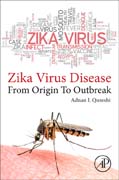
The Zika Virus provides an authoritative and easy to understand account of one of most fascinating viruses of the 21st century. Zika virus is a member of the virus family Flaviviridae transmitted by Aedes mosquitoes. The virus has demonstrated a unique pattern of global involvement and has persisted longer than most outbreaks. The infection spread across the Pacific Ocean between 2013 and 2014, and subsequently to French Polynesia, New Caledonia, the Cook Islands, and Easter Island. In 2015 Zika virus infection spread to Mexico, Central America, the Caribbean, and South America, and was recognized as a global endemic. In January 2016, the U.S. Centers for Disease Control and Prevention (CDC) issued travel guidance on affected countries, including the use of enhanced precautions, and guidelines for pregnant women including considering postponing travel. Since then, CDC reported six confirmed and probable cases of sexual transmission Zika virus from male travelers to women non-travelers and nine cases of U.S. pregnant travelers infected with Zika. Other aspects make this virus infection unique among existing viruses such as the range of clinical manifestations. The infection was thought to cause no or only mild symptoms such as fever and fatigue. However, neurological manifestations such as acute demyelinating neuropathy have been reported. Recently, there is new evidence that suggests that Zika fever in pregnant women can cause abnormal brain development in their fetuses by mother-to-child transmission. Colombia, the Dominican Republic, Ecuador, El Salvador, and Jamaica advised women to postpone getting pregnant until more is known about the risks of Zika virus. The virus infection has become one of the first of such infections when women are actively discouraged from getting pregnant. Covers every important aspect of the Zika virus disease from biological to social and even economic impact that it has caused in the affected regionsAlso focuses on women's health issues that have surfaced, which are the most concerning with birth defects in new bornsWritten in relatively easy to comprehend terms with all efforts to define any technical terms that are sure to be included in the chapters which highlight genetics INDICE: 1. History 2. Etiology 3. Pathogenesis and Pathology 4. Epidemiology and Geographical Distribution 5. Vector and Host 6. Transmission Modes 7. Clinical Manifestations 8. Diagnosis Methods 9. Treatment 10. Prevention and Control
- ISBN: 978-0-12-812365-2
- Editorial: Academic Press
- Encuadernacion: Rústica
- Páginas: 220
- Fecha Publicación: 01/11/2017
- Nº Volúmenes: 1
- Idioma: Inglés
